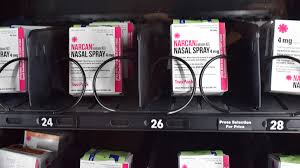Jurisdictions in the US have implemented vending machines for free, private dispensing of naloxone to reverse opioid overdoses
Naloxone is a proven resource in reducing opioid overdose fatalities, but barriers remain to its accessibility, including the stigma of obtaining it from a doctor or pharmacy. A recent innovation to increasing low-threshold access is the installation of self-serve public health vending machines (PHVMs) to dispense naloxone anonymously and free of charge.
Starting in 2017, PHVMs dispensing naloxone, usually only available by prescription, have been installed in many jurisdictions across the US. These include Clark County, Nevada (Las Vegas area); a police department in rural Kentucky; in correctional facilities in Michigan, Indiana, California, and North Carolina; hospitals in Michigan and Indiana; cities such as Los Angeles, New York, Philadelphia, Cleveland, and San Diego; and at college campuses, churches, and libraries. Offering anonymity and convenience, they appear to be accessed frequently, both by opioid users and those who may need to rescue individuals at risk for overdose, e.g., a parent with a teen suffering from opioid use disorder. Sometimes, these vending machines will offer access to other harm reduction supplies and health products.
Data on opioid overdose deaths prior to and after installation of naloxone vending machines in at least two jurisdictions, Clark County, NV (research paper) and Vine Grove, KY (news report) suggest that they have helped reduce such deaths. A 2022 report describes the background, rationale, and processes involved in the U.S. Bureau of Justice Assistance's Regional Judicial Opioid Initiative (RJOI) in Appalachia and the Midwest to introduce naloxone PHVMs.
A report from the National Council for Mental Wellbeing gives an overview of harm reduction vending machines and how they can help communities respond to the opioid crisis, including start-up and operating costs, appropriate settings, data collection, and legal considerations.
Some media accounts of distribution of naloxone via PHVMs are available here, here, here, here, here, and here, and search results on "naloxone vending machines" here.

Vending machine distribution of naloxone has rapidly increased its low-threshold availability to opioid users and those who may be called on to reverse an overdose.








